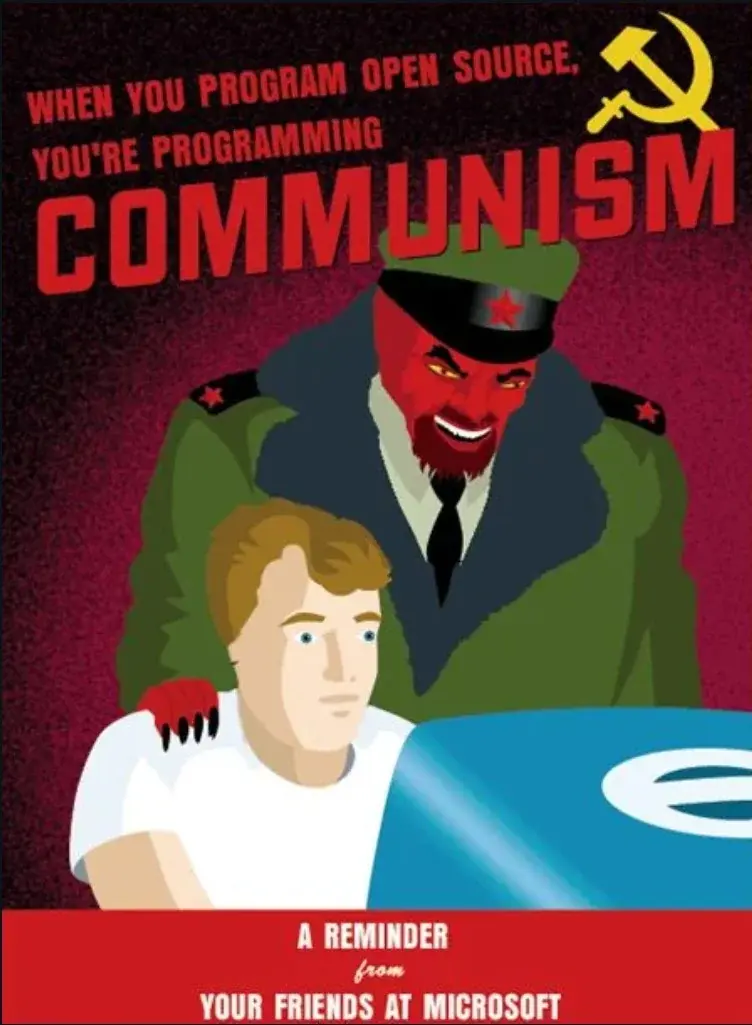this post was submitted on 29 Nov 2023
1365 points (97.4% liked)
linuxmemes
23261 readers
908 users here now
Hint: :q!
Sister communities:
Community rules (click to expand)
1. Follow the site-wide rules
- Instance-wide TOS: https://legal.lemmy.world/tos/
- Lemmy code of conduct: https://join-lemmy.org/docs/code_of_conduct.html
2. Be civil
- Understand the difference between a joke and an insult.
- Do not harrass or attack users for any reason. This includes using blanket terms, like "every user of thing".
- Don't get baited into back-and-forth insults. We are not animals.
- Leave remarks of "peasantry" to the PCMR community. If you dislike an OS/service/application, attack the thing you dislike, not the individuals who use it. Some people may not have a choice.
- Bigotry will not be tolerated.
3. Post Linux-related content
- Including Unix and BSD.
- Non-Linux content is acceptable as long as it makes a reference to Linux. For example, the poorly made mockery of
sudoin Windows. - No porn. Even if you watch it on a Linux machine.
4. No recent reposts
- Everybody uses Arch btw, can't quit Vim, <loves/tolerates/hates> systemd, and wants to interject for a moment. You can stop now.
5. 🇬🇧 Language/язык/Sprache
- This is primarily an English-speaking community. 🇬🇧🇦🇺🇺🇸
- Comments written in other languages are allowed.
- The substance of a post should be comprehensible for people who only speak English.
- Titles and post bodies written in other languages will be allowed, but only as long as the above rule is observed.
6. (NEW!) Regarding public figures
We all have our opinions, and certain public figures can be divisive. Keep in mind that this is a community for memes and light-hearted fun, not for airing grievances or leveling accusations. - Keep discussions polite and free of disparagement.
- We are never in possession of all of the facts. Defamatory comments will not be tolerated.
- Discussions that get too heated will be locked and offending comments removed.
Please report posts and comments that break these rules!
Important: never execute code or follow advice that you don't understand or can't verify, especially here. The word of the day is credibility. This is a meme community -- even the most helpful comments might just be shitposts that can damage your system. Be aware, be smart, don't remove France.
founded 2 years ago
MODERATORS
you are viewing a single comment's thread
view the rest of the comments
view the rest of the comments

Hmm? I wasn't talking about OSI.
If you're thinking BIOS, that was originally IBM proprietary stuff.
OSI started from a lot of telecom companies, who inflicted their silly ideas of Presentation and Session layers on us all.
Actually, it's not that silly, TCP/IP is built on that model, so are many other protocols. Though yes, it can be done better.
TCP/IP does not have a concept of Presentation or Session. Everything above it is just "Application", which is more sensible. There isn't much criticism to be had of layer 4 down, but when they got to layer 5 and 6, they were telecom people sticking their nose in software architecture. You can write networked applications with those layers if you like. I've seen it done, and it's fine. There are also plenty of other ways to architect it that also work just fine.
That is true.
But, you have to understand, back when OSI was made, the only thing which could benefit from it was telecom and banking... there were no PCs as we know them today. It's no surprise that OSI caters mostly to telecom software and needs.
And you could always just use the model up until layer 4, it's pretty good up until layer 4, and just do whatever you like after that... if you're developing your own protocol for something that is.
No I'm definitely thinking of the OSI model lol
What are you talking about, then? What IBM standard did everyone else adopt?
BIOS.
They recognized that PCs were the next big thing and needed one of their own. Large companies don't move fast, and IBM is certainly no exception, but they had to move fast now. So they took a bunch of off the shelf components that anyone else could have bought and called it their PC.
Everything except the BIOS. It regulated how the OS interacts with the hardware. Almost to the point where you could argue DOS isn't an OS at all, but just a thin command line layer over the BIOS, plus a simple minded file system.
Anyway, some people at Compaq make a cleanroom implementation of the BIOS and release an "IBM PC compatible". This quickly becomes the basis of everything we call a PC today. But IBM doesn't get to profit off it in the long run. They sold off their PC division decades ago.
The show "Halt and Catch Fire" has an excellent fictional example of the reverse engineering process.
I'll go out on a limb here and assume they're talking about the IBM PC.